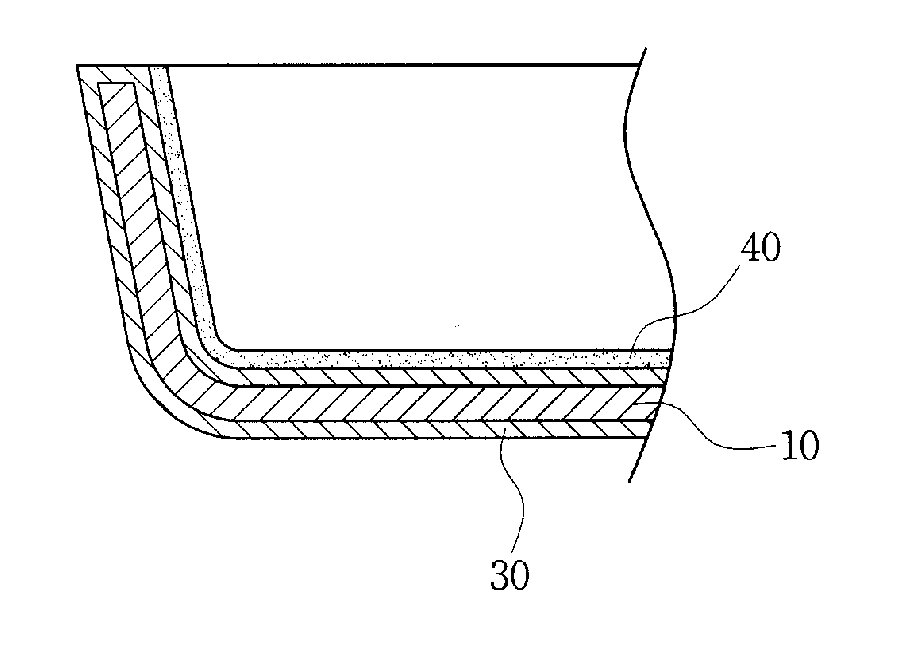Enameled-heated cooking utensils with non-stick ceramic coating layer, and preparation method thereof
a technology of ceramic coating layer and cooking utensils, which is applied in the field of enameled heatcookers, can solve the problems of increasing dissatisfaction of consumers, urgent improvement of heatcookers, and threatening the health of pregnant women or young girls at childbearing ages, so as to enhance the adhesive force, improve the surface roughness of enamel layers, and improve corrosion resistance.
- Summary
- Abstract
- Description
- Claims
- Application Information
AI Technical Summary
Benefits of technology
Problems solved by technology
Method used
Image
Examples
example 1
[0061]The surfaces of a body of the heat-cooker made of an iron and steel material and having a thickness of 2 mm were cleanly pre-treated using sulfuric acid, and then a glaze was applied thereon. Thereafter, the heat-cooker was charged into a calcination kiln. Then, the heat-cooker was pre-dried at 90° C. for 30 minutes, and then hot-dried at 820° C. for 2 hours to form a lower enamel layer and an upper enamel layer having the structure as shown in FIG. 3 into a thickness of 150±30 μm, followed by slow cooling to room temperature.
[0062]Subsequently, the sandblasting was performed by spraying steel balls each having a 60-80 mesh particle size onto on the outer surface of the upper enamel layer at a pressure of 3 kg / cm2 for 20 seconds to increase the surface roughness of the outer surface of the upper enamel layer. Thereafter, a non-stick ceramic coating agent was applied on the sandblasted outer surface of the upper enamel layer and was calcinated at 160° C. for 2 hours to form a n...
example 2
[0066]The surfaces of a body of the heat-cooker made of an iron and steel material and having a thickness of 2 mm were cleanly pre-treated using sulfuric acid, and then a glaze was applied thereon. Thereafter, the heat-cooker was charged into a calcination kiln. Then, the heat-cooker was pre-dried at 100° C. for 10 minutes, and then hot-dried at 950° C. for 1 hour to form a lower enamel layer and an upper first enamel layer having the structure as shown in FIG. 4 into a thickness of 100±30 μm, followed by slow cooling to room temperature.
[0067]Subsequently, the outer surface of the upper first enamel layer was made rough by an activated carbon in the same method as in the above to form an upper second enamel layer thereon into a thickness of 100±20 μm using a glaze containing the activated carbon, followed by slow cooling to room temperature.
[0068]Thereafter, a non-stick ceramic coating agent was applied on the outer surface of the upper second enamel layer which was made rough and ...
PUM
 Login to View More
Login to View More Abstract
Description
Claims
Application Information
 Login to View More
Login to View More - R&D
- Intellectual Property
- Life Sciences
- Materials
- Tech Scout
- Unparalleled Data Quality
- Higher Quality Content
- 60% Fewer Hallucinations
Browse by: Latest US Patents, China's latest patents, Technical Efficacy Thesaurus, Application Domain, Technology Topic, Popular Technical Reports.
© 2025 PatSnap. All rights reserved.Legal|Privacy policy|Modern Slavery Act Transparency Statement|Sitemap|About US| Contact US: help@patsnap.com



